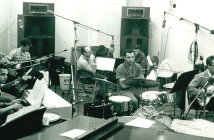
Family Nest (1979)
Cast: Laszlone Horvath, László Horváth, Gábor Kun
Director: Béla Tarr
Country: Hungary
Genre: Drama
Editor’s Notes: The following review is part of Next Projection Presents Apocalyptic Poetry: The Films of Bela Tarr. Please look out for more of our original series throughout 2015.
Bela Tarr’s realist drama, Family Nest (1979), shifts modalities to realize an authentic layering of different forms of being. What begins as a social drama is soon transformed first into a family drama and second into an individual/humanist one. By commencing on the crowd and completing on the creature, Tarr’s commentary truly seeks to recognize the universality of its characters’ circumstances. In effect, it is not just this family nor just this husband and wife who face the struggle presented on screen. In 1979 Hungary, the concern for livable space, as seen in the film, is one which burdened many families.
What begins as a social drama is soon transformed first into a family drama and second into an individual/humanist one.
Declared a “true story”, Tarr’s fictional drama uses actors and a script to realize something more akin to a socio-political documentary. It allows fictional elements but uses this to draw a more intimate portrait of life in Hungary circa 1979. In the observational documentary mode, a handheld camera traverses first the streets, then the home, then the face, as a method of examining the various levels of a person’s life. As the film proceeds from the social to the individual, its dramatic flare and fictional mode of filmmaking become more obvious as the viewer begins to empathize with the characters on screen.
 With its first scenes focusing on a factory and a workplace, Family Nest assumes its place amongst the other neo-realist socio-political documentaries of its time. With much of its key techniques taken from neo-realism—on location shooting, deep focus cinematography, non-actors, etc.—it provides a stark observation of society. It is clear in these few scenes how the social system has, at this time, put many out of work and even more into financial difficulty. Showing the city in black and white, Tarr’s languid camera movement establishes a point of departure. In its focus later on the family and then the individual, it is evident that the unfolding drama begins at the level of the social and that the each individual struggle is in some sense a microcosm of social suffering.
With its first scenes focusing on a factory and a workplace, Family Nest assumes its place amongst the other neo-realist socio-political documentaries of its time. With much of its key techniques taken from neo-realism—on location shooting, deep focus cinematography, non-actors, etc.—it provides a stark observation of society. It is clear in these few scenes how the social system has, at this time, put many out of work and even more into financial difficulty. Showing the city in black and white, Tarr’s languid camera movement establishes a point of departure. In its focus later on the family and then the individual, it is evident that the unfolding drama begins at the level of the social and that the each individual struggle is in some sense a microcosm of social suffering.
In its longest and most notable scene, a family dinner and discussion is shot entirely in close up. The claustrophobic habitat, a home for nine individuals including three families, is made ever-more cramped by the camera’s incessant desire to observe everything in close up. The single hand held camera becomes an observer, a bystander examining the ticks of these families. With great naturalness, the many characters on screen carry on multiple conversations at once. It is exceptionally genuine, but also quite overwhelming. In all the chaos, it is difficult to establish a sense of space, which of course is one of Tarr’s aims. Our comfort is sacrificed, and our sudden disorientation is a matter of understanding the disorient that is rife in the lives of each character on screen.
The scattered conversation an expression of scattered thoughts, the family dynamic is seen as another burden, like the social dynamic, which causes the individual to suffer.
The scattered conversation an expression of scattered thoughts, the family dynamic is seen as another burden, like the social dynamic, which causes the individual to suffer. Conflict between the father and daughter in law begins to tear apart the fabric of two families, the new and the old, the generation and the generational. What’s seen as salvation is a flat of their own. If the husband and wife can find a way to get a flat of their own, they will be able to live comfortably enough that everything else will fall into place. But the system doesn’t have a flat for them, and the family doesn’t have the money for them. As such, society and family continue to keep the individual in constant struggle.
For much of its third act, Family Nest is made up of monologues. First the wife then the husband, well acted powerful statements put the individual in context. From social to political to familial, first hand accounts of struggle are presented on screen by individuals who become archetypes of the average citizen. Through exposition, the general social struggle as well as the individual struggle are made all too clear.
While Tarr’s first feature film, Family Nest, is a genuine and valuable example of both social and neo realism, the film is at times somewhat dull and monotonous. Its penchant for the observational becomes a detriment at times, as it prevents the film from finding a pulse that more strongly resonates with the viewer. Though resonance becomes more lasting as the film focuses on individual characters, its (over) use of expository monologue is cumbersome. Mostly just repeating what was already established by the observational camera, the monologues only serve to beat the dead horse. What’s more, by concluding the film with music about having a house, Tarr’s overzealousness gets the best of him. Its repetition and eventual narrowness undermine the authentic illustration of life once seen in the film.
Bela Tarr’s realist drama, Family Nest (1979), shifts modalities to realize an authentic layering of different forms of being.



